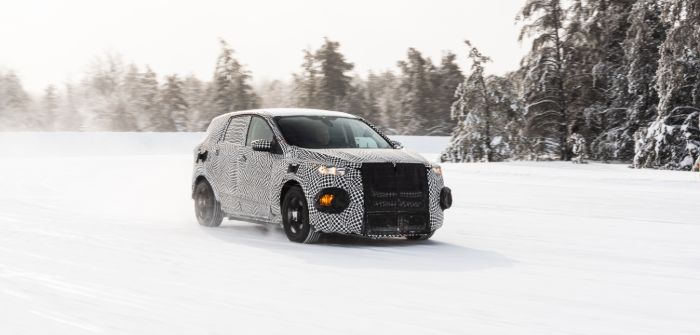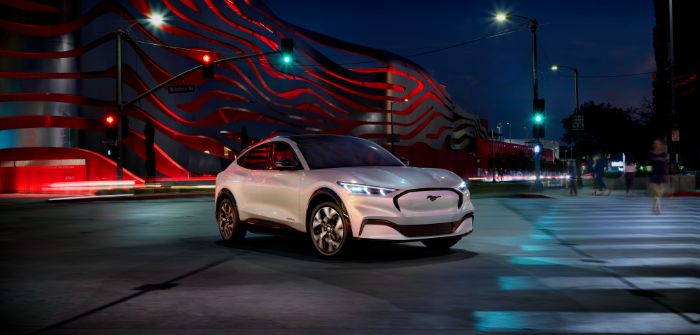Ford certainly got people talking when it took the wraps off the Mustang Mach-E ahead of the
2019 Los Angeles Auto Show. An all-electric SUV carrying the name of an iconic sports car has challenged perceptions of what an EV and a Mustang can be – not just among vehicle enthusiasts, but also within the design and development team behind the Mach-E.
The challenge was made more acute by a fundamental shift mid-way through the program. Engineers had already spent two years developing what Ford is calling “a compliance car” – a product that it needed to build in order to be compliant in zero-emissions markets – when in the summer of 2017 a ‘pivot’ was made to a product that would carry the Mustang name.
“It was a lot of work to make the pivot to Mustang,” says Ron Heiser, Mach-E’s chief program engineer. “The pressure was on to deliver performance. To deliver the attributes and appearance that you need to be able to carry a Mustang pony has been very challenging.”
The resulting development program has been a combination of tried-and-tested Ford practice with some unique attributes. First up, the software development around the vehicle, including cloud communications, a new Sync 4 HMI and a new charging network, increased the breadth of the product development team. There were close ties with Ford’s EV-focused, Corktown, Detroit-based Team Edison, but most engineers remained at the regular product development center in Dearborn.
“We held a lot of small-group, collaborative discussions and pulled in different leadership stakeholders to drive decisions quickly,” says Heiser. “We took a nimbler approach than our traditional process would have done.
“We had a weekly directors meeting in our studio – the engineering directors, studio directors and me.
It was an issues-driven meeting – we needed to talk about the shape of the hood, or the lamp package, for example. We would bring in the right people and gain quick alignment on how to move forward. That wasn’t just because the vehicle was seen as a priority, but also because we were already about two years into a program when we pivoted to Mustang. With that pivot came changes – we had the basic architecture bones, but we still had to stretch it and do things to get the Mustang proportions, so now we were really under the gun for timing.”
Two further departures from the norm involved the increased use of digital tools, firstly in the design studio, which did more on screen before moving to clay for the final refinements, and also in the driver-in-the-loop simulator laboratory.
“When we pivoted into Mustang and we were changing some platform elements, we not only used a lot of CAE-based analysis, but were the first production program in Ford Motor Company to use our Ford Performance simulator in North Carolina,” says Heiser. “We were able to take all our inputs – whether that was body structure or chassis systems – and make tweaks. We’d drive the car as it was set up and then change the bushings, or spring rate, or tire compounds. It enabled us to quickly understand what that was doing to the ride and handling characteristics of the car. That really helped us with that Mustang pivot,
to get the bones done right before we got into physical prototypes.”
A Ford video on the Mach-E’s development shows Dave Pericak, Ford’s global director and a former Mustang chief engineer, recalling his reaction to his first drive of a digital prototype in the DIL simulator: “I looked at the entire team and said, ‘It’s not a Mustang.’ You could almost feel the air leave the room. We had all the fundamentals in place, but it was all about the fine-tuning. We had to go back and make it
a Mustang.” Pericak revised his opinion after the team made changes.
“We felt that the simulator technology was robust enough to provide us not just with directional feedback, but precise feedback,” Heiser adds.
This wasn’t an all-digital program, however. When it came to the range-extending aerodynamics, Heiser, who is an aerospace engineer with an aerodynamics background, says that it was still essential to develop the shape in a wind tunnel.
“We started out with CAE, but then we refined in the tunnel,” he explains. “CAE will take you to a certain point, but we’d get into specific elements, like the lower corners of the car, front and rear. They were critical, and shaving or adding millimeters in certain places could give you a few counts of aero.”
Escape to victory
The Mach-E architecture had started life in mule vehicles, based on old-model Escapes that had been cut and stretched to accommodate the battery pack and high-voltage electrical system. Rework was required following the switch from the front-wheel-drive compliance car to a rear-wheel-drive/all-wheel-drive Mustang, specifically on getting the rear drive unit between the rear wheels.
“We’d done a lot of work in the front-end structure on how we wanted the [crash] profile to work, the free crush space, and so forth,” adds Heiser. “And since the compliance car was a front-drive at the time, that gave us a leg up on the worst-case, which is AWD.”
Technical benchmarks included Teslas and the Nissan Leaf. “We found some interesting and good things that they’d done and some interesting things that we didn’t necessarily think were right for us,” he comments.
Prototype to production
The LA show cars were engineering prototypes, validation vehicles built in Ford’s prototype facility in Dearborn. At the time of the show, the team was conducting confirmation tests ahead of the start of the production launch in 2020. The show cars already featured many early production-tooled components, according to Heiser.
“Nearly all the metal is production tooled – under the surface, all the metal,” he says. “But I also have production tooled parts now, for example for the hood. The show car’s hood is from a prototype tool, but I’m building cars now with production hoods. The drivetrain and chassis, other than the tunable bits, are all from production tooling.
“With our CAE capabilities, we’re building fewer prototypes than on some of our typical programs,” he continues. “We’ve been able to lean into the tools, including the simulator, to become very efficient
in the product development process.
“So many engineers have stepped up, it has been an unbelievable effort by the entire engineering team – and it still is,” Heiser concludes. “This isn’t the finishing line for us, it’s just the starting line of going to market. We still have more engineering work to do and have to get into our assembly plant [in Cuautitlán, Mexico] and get this bad boy out on the road. Getting the part pedigree right and the assembly process right is a challenge for any program.”
 Bigger and better?
Bigger and better?
One look inside the Mach-E and you can’t fail to notice the huge, 15in portrait touchscreen at the center of the dashboard. The original specification called for an 8in screen with a 10in option, but that was later dropped in favor of a 12.3in landscape screen before that, too, was superseded by the final design, which also brought the HVAC controls onto the screen.
“Team Edison was in China about midway through the program development,” relates Joel Piaskowski, Ford’s global design head for cars and crossovers. “From spending time talking to customers, they said we had to go bigger, that customers were expecting a much larger interface.
“In conjunction with creating a much larger screen, we deployed a new, cross-functional HMI development team, Team Menlo, to design, build and prototype the whole interface. The idea was to put everything at the customer’s fingertips and eliminate all the visual clutter of hard buttons.”
The result is Sync 4, an interface that adapts to its users’ behavior. As Ron Heiser puts it, “A year out, your vehicle will be different, better, than when you bought it.”
Hushed up
Given the radical nature of the product and huge public interest in anything with a Mustang badge, Ford did a good job of keeping details of the Mach-E under wraps until the official unveiling in November 2019. “The entire team had to be diligent when it came to verbal leaks,” says Ron Heiser. “We liked the feeling of flying under the radar.
Lots of other people were coming out with products and some of the more established EV OEMs were talking about other traditional OEMs besides Ford. We probably went a bit over the top with our fully camouflaged vehicle, which looked quite a bit like a big station wagon. That was probably the biggest difference from a regular program; otherwise we followed our normal protocol.”


